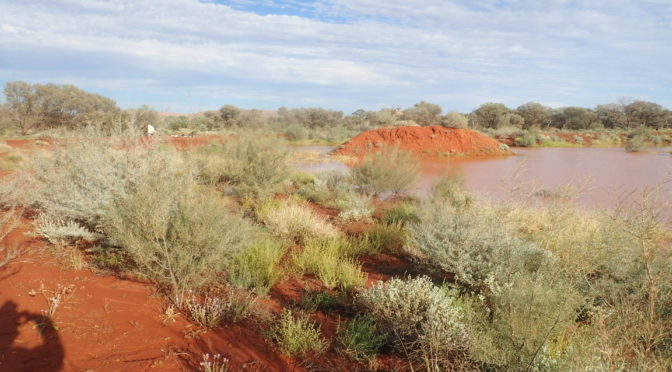My camp flooded!
About 10 pm the rain got heavier and I congratulated myself that the 14 year old tent (that I had re-waterproofed with a coating of 1 part pure gutter silicone to 10 parts mineral turpentine) didn’t leak.
About 11 pm I woke to feel the beautiful Gong Li licking my toes. A moment later I realized it wasn’t Gong Li but the bottom of my tent was sinking into water. No great worry, I had assessed that the bank of the gravel pit that I had camped on was well above the previous high water mark.
At about 11:10 the water was up to my waist and things were getting serious. Grab all the electronic gear (phone, camera, satellite tracker, big batteries), throw it in a shopping bag, put that in my backpack and throw it up on a mound of dirt on the edge of the gravel pit.
Now, picture this; Stuart, naked but soon to grab a raincoat, rushing about in the midnight dark pulling gear out of his flooded tent before it floated off deeper into the flooded gravel pit, hauling gear, tent and bike to the highest ground he can find.
Finally having rescued everything, what to do? The flat landscape was, as predicted when camp was pitched, 50 mm deep in rainwater with light rain still falling. Nothing for it, lay out the groundsheet in the water on a rock-free expanse, roll out the sleeping mat, put the sopping wet sleeping bag on it, get into said sleeping bag (50 mm in the water), roll the lot in the groundsheet and go back to sleep. By this stage it is about 12:15 am.
Next, as expected, the cold change that had brought the torrential rain that caused the flooding, had really moved in, the skies had cleared and the wind dropped. The cold front really was cold so the previously warm night now suddenly dropped to shaking cold so get out of soaking wet sleeping bag, wring it out, move it and ground sheet to some now drained off flat area nearby, again roll myself in said sleeping bag, pull wet beanie down over ears, and again go to sleep until morning.


With the daylight came some warmth and the need to start assessing the situation at length. Gear was wrung out, separated and spread out to dry. Fortunately the cold front had brought sunshine, mild (not actually warm) temperatures, dry air and a light breeze. By 10 am things had dried enough to pack them up and get moving.


Of course, the heavy overnight rain had set the creeks flowing so I had three or four flowing streams to cross during the day. Rather than get water in the wheel bearings and possibly into the bottoms of the panniers I had to take everything off the bike and carry it all across the flowing creek in three or four trips. I got quicker at it as the day went on.

The road had also become a series of lagoons (remember that on the red sand a road is simply a grader scrape down to the hard (when dry) layer of clayey sand about 30 cm below the surface. As the hard surface wears under vehicles, a grader keeps scraping the top off to find another hard surface deeper down). So again, lots more weaving around lagoons, some a hundred metres or more long, riding up on the road batter or pushing the bike through soft sand.

Nowhere to camp off the road because the spiky spinifex was just too continuous. So pitch camp about 20 m from the road but no issue as no-one travels at night out here. I think this is because there is too much risk of hitting a camel.
Finally set up camp, ate dinner (the cigarette lighter had dried out so could light Trangia), crawled into very damp sleeping bag and went to sleep while trying to avoid movements that would bring warm legs into contact with cold parts of the sleeping bag.

